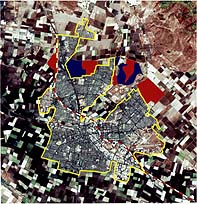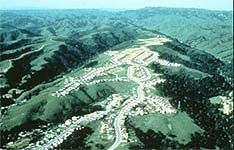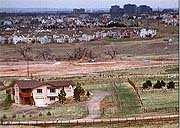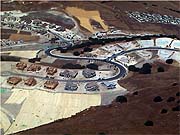|
 Introduction Introduction
- Not
everyone approaches planning in exactly the same way.
-
Good land use planning should be based on and reflect the
community’s choice.
-
We, as a community, can choose the kind of future we want.
|
|
|
 Recommended
Policy Recommended
Policy
- Protect
Private Property Rights
-
Assures property owners that their private property rights
will be protected.
- Allows
elected officials to adopt strong planning policies with
confidence.
|
|
|
Discussion
- What
kind of evidence is necessary to constitute taking of property?
-
Can such policies be amended to avoid such an unconstitutional
taking?
How can local government officials do what is best without
the need to fear long and costly litigation?
|
|
|
 Affordable
Housing Affordable
Housing
- A
large and growing percentage of individuals and families
cannot obtain affordable housing in their community.
-
Lack of affordable housing leads to overcrowded, substandard,
and unsafe housing conditions.
-
The high cost of housing drains the scarce financial resources
of average and below average income families.
-
 Long
commutes, to find lower-cost housing, undermine family and
community stability. Long
commutes, to find lower-cost housing, undermine family and
community stability.
|
|
|
An
Approach to the Problem
- A
General Plan requirement that all new development contribute
to addressing the community’s affordable housing problem.
-
A planning decision to increase the ratio of “medium”
and “high” density development, to reduce land
cost per unit basis.
-
An affirmative requirement to offer new housing first to
persons who live and work in the jurisdiction in which the
housing is constructed.
|
|
|
 Recommended
Policies Recommended
Policies
- A
Policy Commitment To Affordable Housing.
-
“Affordable Housing” Defined.
- An
“Inclusionary” Requirement For New Residential
Development.
- New
Jobs and Housing Go Together.
- Establish
Minimum Density Requirements.
 More
Land For Medium and Higher Density Development. More
Land For Medium and Higher Density Development.
- Ensure
A Range of Housing Types.
- “Mixed
Use” Developments To Increase Housing Opportunities.
- Design
Housing To Meet Community Needs.
- First
Right To Rent or Purchase.
|
|
|
Discussion
- Will
imposing affordable housing requirements increase the cost
of market-rate housing?
- Will
the requirements really benefit those who face the most
difficult housing situation?
- Can
housing be made permanently affordable?
- What
are resale restrictions?
- Does
high density mean high crime?
|
|
|
 Preserving
Agricultural Land Preserving
Agricultural Land
- Preserving
agricultural land is a matter of economics
- Gross
revenues from agricultural production in Monterey County
were over $3 billion dollars in 2001.
-
Each acre of agricultural land in Monterey County produces,
on average, more than $10,000 per year in gross revenue.
 When
agricultural land is converted to urban uses, the jobs and
revenues associated with that land disappear, and public
costs increase. When
agricultural land is converted to urban uses, the jobs and
revenues associated with that land disappear, and public
costs increase.
- In
Monterey County, between 1984 and 2000, 2,363 acres of prime
agricultural land were converted to nonagricultural uses.
 In
Salinas, where large amounts of agricultural land have been
converted to residential subdivisions, community debt went
from zero in 1984 to $150,000,000 in the year 2000. In
Salinas, where large amounts of agricultural land have been
converted to residential subdivisions, community debt went
from zero in 1984 to $150,000,000 in the year 2000.
- By
2020, the local economy will be foregoing $217,820,000 in
agricultural revenues each year.
|
|
|
 An
Approach to the Problem An
Approach to the Problem
- Adopt
and enforce policies that apply to agricultural lands in
unincorporated areas.
- Focus
on requirements that maintain the use of agricultural land
for agricultural use.
- Prevent
development or division of commercially productive agricultural
land.
|
|
|
 Recommended
Policies Recommended
Policies
- Agricultural
Land Shall Be Conserved For Agricultural Use.
- The
Subdivision of Agricultural Lands Shall Be Discouraged.
- Agricultural
Buffer Setbacks.
- Maintaining
The Right To Farm.
- No
Utility Extensions Into Agricultural Land.
- Establish
An Agricultural Land Protection Boundary.
|
|
|
 Discussion Discussion
- Will
strong agricultural land use policies take away a property
owner's right to develop such lands?
- If
we can’t build homes in agricultural land, where will
we build?
- What
about the growth pressures?
- Will
these policies create a “no growth” mentality?
|
|

Pasadera,
Monterey County |
Stopping
Sprawl
Sprawl
happens when county governments allow residential, commercial,
or industrial developments to take place on an individual
and disconnected basis. This kind of rural sprawl is typical
in Monterey County and throughout California.
Most
modern urban subdivisions are:
- Anti-pedestrian.
- Auto-dependent.
- Low-density,
single-family dwellings separated from all other things
that go along with urban life.

Urban amenities are not really available to the residential
neighborhoods, and, the peace, quiet, and beauty that
motivates people to move to the suburbs isn’t really
present, either. |
|
|
|
 An
Approach to The Problem An
Approach to The Problem
- Counties
need to be committed to maintaining rural areas as rural.
- Direct
future growth and development to existing cities where services
can be provided.
- Adopt
Urban Growth Boundaries.
- Infill
with mixed-use development to revitalize neighborhoods left
behind.
|
|
|
 Recommended
Policies Recommended
Policies
- Counties
Will Direct Growth To Cities and Existing Urban Areas.
- Cities
Will Establish An Urban Growth Boundary.
- Cities
Will Employ “Traditional Neighborhood Design”
Principles.
|
|
|
Discussion
- Should
local governments be making these kinds of decisions?
- Are
current market-driven development patterns producing unlivable
and unaffordable communities?
- Will
these policies really help to revitalize and sustain our
social and community life?
|
|
|
 Natural
Resource Protection Natural
Resource Protection
- Growth
and development place significant pressures on our natural
systems.
-
Policies that steer new growth toward existing will protect
our natural resources.
- The
best policy approach is simply to prevent development or
other activities that might injure natural resources.
|
|

Las Palmas, Monterey County |
Recommended
Policies
- Protect
Sensitive Habitats.
- Minimize
Land Disturbance and Erosion.
| Las
Palmas, Monterey County |
|
|
|
 Discussion Discussion
- Will
these policies restrict our enjoyment of our natural areas?
- Is
the protection of the environment more important than building
homes for people?
|
|
|
Transportation
and Transit
- Transportation
and traffic problems are epidemic.
- Transportation
and traffic problems are associated with the lack of jobs-housing
balance.
- When
desirable and affordable housing is not available, workers
must commute.
- It
is not possible to build our way out of our transportation
and traffic problems.
|
|
|
 An
Approach to the Problem An
Approach to the Problem
- Changing
land use development patterns is an antidote to our traffic
and
- transportation
problems.
- Better
land use practices can start making a difference immediately
and can provide real and significant change over time.
|
|
|
Some
Ideas from the San Diego Air Pollution Control District
- Encourage
greater mixing of land uses to reduce vehicle trips.
- Encourage
the development of pedestrian-oriented communities.
- Encourage
infill and neighborhood revitalization projects within urban
residential areas.
- Specify
design and roadway features to enhance pedestrian and bicycle
access to transit.
- Ensure
that upgrades to existing roads include bicycle and pedestrian
improvements where appropriate.
|
|
|
Recommended
Policies
- The
Local Government Shall Compile and Maintain a List of Alternative
Transportation Strategies.
- Recommendations
From the Local Transportation and Transit Agency Shall Be
Incorporated Into Projects.
- Require
New Residential, Commercial, Industrial, or Office Development
to Mitigate Any Transportation Impacts Caused By Development.
- Require
Conservation Easements On Parcels Adjacent to Proposed Transportation
Facilities.
|
|
|
Discussion
- Will
these policies really have an affect on our current traffic
problems?
- Will
people give up the convenience of driving?
- Do
the policies promote a “no growth” approach?
Who is going to pay for it?
|
|
|
 Water
and Land Use Water
and Land Use
- Adequate
and sustainable water supplies are not available to serve
new development.
- Continued
pumping of overdrafted aquifers lowers the water table,
increasing pumping costs.
- Approving
developments that don’t have a sustainable water supply
jeopardizes community investments.
|
|
|
An
Approach to the Problem
- A
simple, but strict, General Plan policy can help address
the problem.
- Implement
at the local level recently adopted state policy.
- Require
new development to demonstrate the availability of a sustainable
water supply.
- The
overall state of groundwater must be examined whenever development
relies upon it.
|
|
|
 Recommended
Policies Recommended
Policies
- Sustainable
Water Supply Required.
- Prohibition
of Hauled Water.
|
|
|
 Discussion Discussion
- Will
these policies restrict development when housing units are
so desperately needed?
- Do
these requirements prevent developers from being “creative?”
- Will
these restrictions apply to all development?
|
|
|
 Permit
Process Reform Permit
Process Reform
- The
permit process causes significant problems to both developers
and public.
- The
process is slow and costly.
- The
process often provides only the illusion of genuine public
participation.
|
|
|
 An
Approach to the Problem An
Approach to the Problem
- Local
governments can decide not to process project applications
that are inconsistent with the adopted General Plan.
- Make
the need for specialized studies the exception, rather than
the rule.
- Involve
the public at the beginning of the project.
|
|
|
 Recommended
Policies Recommended
Policies
- General
Plan Amendments Separated From Project Applications.
- Early
Public Involvement Encouraged.
- General
Plan Standards Should Provide Certainty.
|
|
|
Discussion
- Can
property owners request a change to the General Plan after
the it has been adopted?
- What
does “internally consistent” mean?
- Why
not consider every project?
|
|
|
Conclusion
- The
future of our community is shaped by countless individual
decisions, added up.
- A
local General Plan represents a set of decisions made at
a policy level.
- It
really is possible for a community to shape the future it
wants by adopting the right General Plan policies.
|
|
|
Our
thanks to the Clarence E. Heller Charitable Foundation for
the generous grant that underwrote the research, writing,
and publication of our newest “best policies” guidebook,
Land Use and the General Plan.
Thank
you for being here!
If
you’re not already a member, please join
LandWatch today!
|
|




 Introduction
Introduction Recommended
Policy
Recommended
Policy Affordable
Housing
Affordable
Housing  Long
commutes, to find lower-cost housing, undermine family and
community stability.
Long
commutes, to find lower-cost housing, undermine family and
community stability. Recommended
Policies
Recommended
Policies  More
Land For Medium and Higher Density Development.
More
Land For Medium and Higher Density Development. Preserving
Agricultural Land
Preserving
Agricultural Land When
agricultural land is converted to urban uses, the jobs and
revenues associated with that land disappear, and public
costs increase.
When
agricultural land is converted to urban uses, the jobs and
revenues associated with that land disappear, and public
costs increase. In
Salinas, where large amounts of agricultural land have been
converted to residential subdivisions, community debt went
from zero in 1984 to $150,000,000 in the year 2000.
In
Salinas, where large amounts of agricultural land have been
converted to residential subdivisions, community debt went
from zero in 1984 to $150,000,000 in the year 2000. An
Approach to the Problem
An
Approach to the Problem Recommended
Policies
Recommended
Policies Discussion
Discussion

 An
Approach to The Problem
An
Approach to The Problem Recommended
Policies
Recommended
Policies Natural
Resource Protection
Natural
Resource Protection
 Discussion
Discussion An
Approach to the Problem
An
Approach to the Problem Water
and Land Use
Water
and Land Use Recommended
Policies
Recommended
Policies Discussion
Discussion Permit
Process Reform
Permit
Process Reform An
Approach to the Problem
An
Approach to the Problem Recommended
Policies
Recommended
Policies